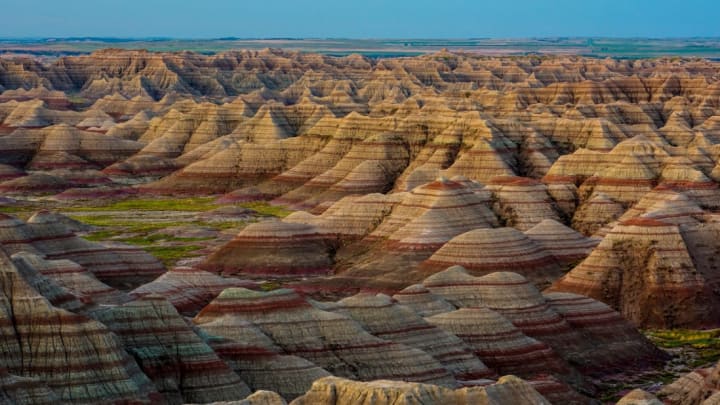10 Rugged Facts About Badlands National Park

Established in 1978 [PDF] and covering 244,000 acres of South Dakota, Badlands National Park is home to one of the most distinct landscapes in the country. Close to 1 million people visit the site each year to see the formations striped by millennia of sedimentary rock. Here are some facts worth knowing about the park.
1. IT USED TO BE A SEA ...
The Badlands were covered by a shallow sea when they first started forming 75 million years ago. As the water receded, it left behind sediment (grains of clay, sand, or silt) that helped form the plateaus and pinnacles that make up the landscape today. The ancient sea also left behind a trove of fossils. The Oglala Lakota [PDF] people were the first to uncover large fossils of bones and shells in the area and deduce that the land had once been underwater.
2. ... AND THE TERRAIN WAS SHAPED BY WATER.
The rock formations at Badlands are characterized by their unusual shapes and vibrant red, tan, and white stripes. Both features are products of the powerful waters that have shaped the site. Each stripe in the rocks represents a different layer of sediment that was swept there by rivers and seas millions of years ago. Over time, that wet mud and grit hardened into sedimentary rock, with the old rock layers starting at the bottom and becoming gradually newer the closer they get to the top.
Depositing sediment wasn’t the only way water helped shape the landscape. About 500,000 years ago, after most of the sedimentary rock had already formed, erosion from the White, Bad, and Cheyenne rivers began carving away at the flat floodplain. This resulted in the sloping hills, jagged cliff faces, and precarious spires that now draw visitors to the park.
3. THE ROCKS ARE STILL ERODING.
At Badlands National Park, you can witness a geological wonder. The forces of nature that sculpted the park over so many years are still at work, which means the terrain is constantly, albeit slowly, shifting. According to the National Park Service, the Badlands erode at a rate of one inch per year.
4. IT’S MORE THAN PRETTY ROCKS.
Badlands isn’t all dirt and rocks. The park is also home to one of the country's largest areas of mixed-grass prairie. That means both ankle-high grasses and waist-high grasses grow abundantly there. According to scientists, the ecosystem fosters over 400 species of plant life.
5. THE NAME MEANS EXACTLY WHAT YOU THINK IT DOES.
The Oglala Lakota people were the first to give the site of modern-day Badlands National Park a name. They dubbed the harsh, rocky landscape mako sica, which translates to “land bad.” When the French arrived, they had the same idea. They called the region les mauvaises terres a traverser, or "bad lands to traverse."
6. IT’S APPEARED IN BLOCKBUSTERS.
If you’re unable to visit Badlands National Park in person, you can see it on film as the backdrop of some popular movies. At the beginning of the 1990 film Dances With Wolves starring Kevin Costner, the park is used as the setting for part of Lieutenant Dunbar’s wagon trek. The otherworldly terrain has even appeared in science fiction. In Starship Troopers (1997), the landscape stands in for an alien planet of man-eating bugs. It’s used as the surface of an asteroid in the 1998 film Armageddon.
7. IT’S A HOTSPOT FOR FOSSILS.
The same forces that shaped the Badlands also embedded fossils there millions of years ago. The site is home to more late Eocene and Oligocene mammal fossils than any other place on Earth. Some of the ancient creatures whose remains have been uncovered there include three-toed horses, rhinoceroses, and marine reptiles. Badlands fossils are on display along the park's Fossil Exhibit Trail and in museums around the globe.
8. IT WAS THE SITE OF THE ‘GHOST DANCES.’
Indigenous tribes used the Badlands as hunting grounds for thousands of years, and in the late 19th century much of that land was taken from them [PDF]. White settlers were moving into South Dakota and pushed the Oglala Lakota from their homes. In response, a Native American prophet named Wovoka began organizing "Ghost Dances" on Stronghold Table in the Badlands where his followers danced while wearing "Ghost Shirts" they believed to be bulletproof [PDF]. The ritual was meant to restore the area back to its pre-colonial state. Instead, the dances ended with the Wounded Knee Massacre in 1890, which saw 300 Indians shot and killed by United States Cavalry officers. Today the Stronghold District falls inside Oglala Lakota territory and is managed by the National Park Service.
9. IT WAS USED AS A BOMBING RANGE DURING WORLD WAR II.
The Stronghold District’s tumultuous history extends beyond the Ghost Dances. During World War II, when Badlands was just a national monument, the U.S. Air Force seized 341,726 acres of Oglala Lakota land and turned it into a gunnery [PDF]. The space was used to test air-to-air and air-to-ground explosives, and undetonated bombs are still being discovered in the area today.
10. A NATIVE SPECIES IS MAKING A COMEBACK.
Black-footed ferrets, once widespread across the Great Plains, came close to extinction in the 20th century. Prairie dogs are their main food source, and the destruction of this prey population had a drastic effect on ferret numbers. Experts once thought the species had been wiped out for good, but in the 1980s a small ferret colony was spotted in Meeteetse, Wyoming. That group was captured and used as the basis for a population rebuilding program. In 1994, the first batch of captive-bred ferrets were reintroduced to Badlands National Park where they once roamed wild. Today, there are hundreds of ferrets in the area [PDF] and the park has even hosted a black-footed ferret festival.